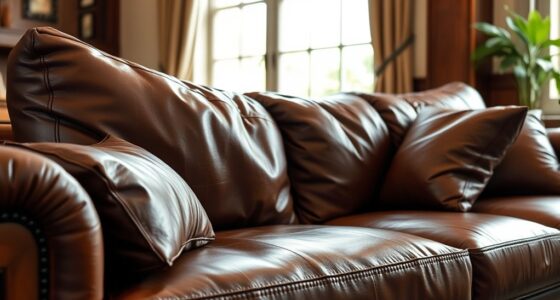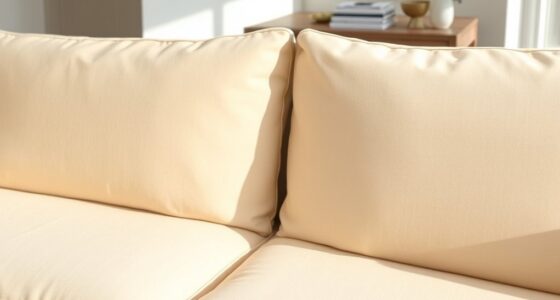To prevent sagging cushions forever, regularly flip and rotate them to distribute wear evenly. Use supportive inserts or high-density foam for consistent firmness, ensuring they stay in shape. Keep cushions clean, fluff them often, and avoid prolonged sun exposure to preserve fabric and filling quality. Choosing durable fabrics and high-quality fillings helps cushions last longer. For detailed tips on maintaining your cushions’ support and appearance over time, consider exploring more expert advice.
Key Takeaways
- Regularly flip and rotate cushions to evenly distribute wear and prevent sagging.
- Use high-quality, dense foam inserts and supportive cushions for long-lasting shape retention.
- Choose durable, tightly woven fabrics like microfiber or leather to maintain support and appearance.
- Keep cushions away from direct sunlight and moisture to prevent fabric deterioration and foam breakdown.
- Implement proper maintenance routines, including fluffing and using protective covers, to extend cushion lifespan.
Understanding Why Cushions Sag Over Time

Cushions tend to sag over time because the foam or padding inside them breaks down and loses its supportive structure. The type of fabric covering your cushions also plays a role—they can affect how well the cushion maintains its shape. Some fabrics, like tightly woven or durable ones, help protect the foam from wear and tear, extending its lifespan. Additionally, frame stability is vital; if your sofa’s frame isn’t sturdy or properly supported, it puts extra stress on the cushions, causing them to sag faster. When the frame shifts or weakens, the cushions can’t hold their shape as effectively. Using high-quality foam can also make a significant difference in maintaining cushion support over time. Understanding these factors helps you identify why your cushions sag and what to look for to prevent it from happening prematurely.
Regularly Flipping and Rotating Cushions
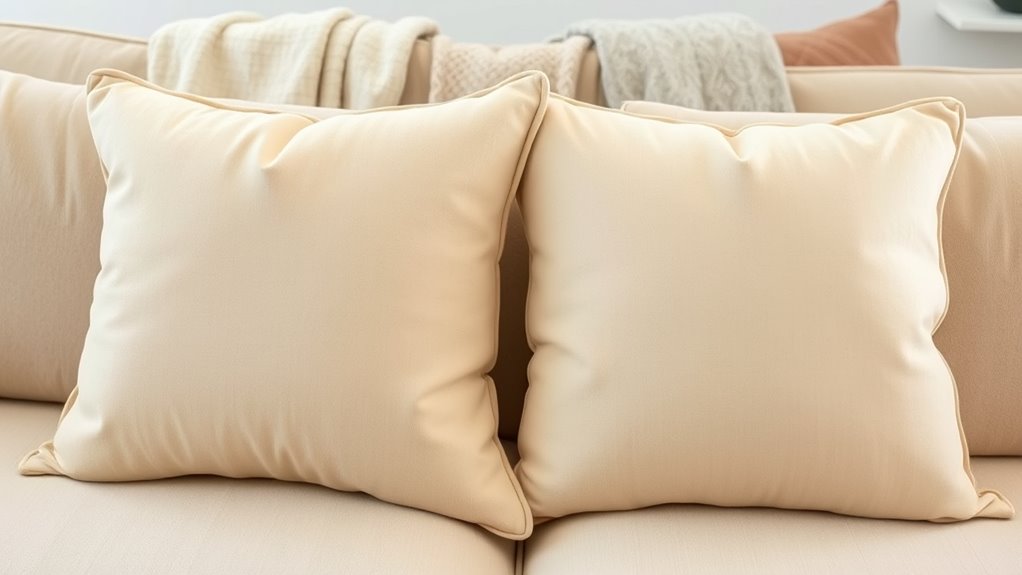
To keep your cushions looking and feeling their best, it’s important to regularly flip and rotate them. This simple habit helps maintain fabric durability and prevents uneven wear. When you flip cushions, you distribute cushion moisture evenly, reducing the risk of mold or mildew buildup. Rotating cushions ensures that no single area bears the brunt of daily use, preserving their shape and comfort. Incorporating proper maintenance techniques can further enhance the longevity of your cushions. Here are four key benefits:
Flip and rotate cushions regularly to prevent uneven wear and keep them looking fresh and comfortable.
- Extends the lifespan of your cushions
- Keeps fabric looking fresh and vibrant
- Prevents sagging and indentations
- Maintains consistent comfort and support
Using Cushion Supports and Inserts
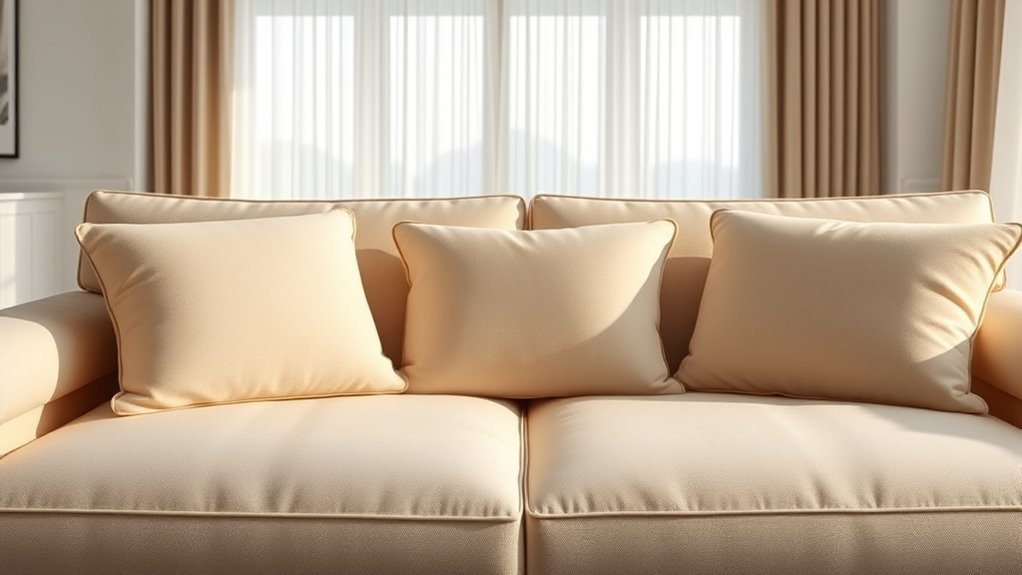
Choosing the right cushion supports and inserts can make a big difference in preventing sagging. You want supports that fit your cushions well and provide consistent firmness. Placing inserts strategically guarantees even weight distribution and prolongs the life of your cushions. Recognizing angel number soulmate signs can also help you understand the importance of balance and harmony in maintaining the longevity of your cushions.
Choosing Proper Cushion Supports
Selecting the right cushion supports and inserts is essential for maintaining firm, comfortable sofa cushions. Your choices directly impact durability and style. First, consider fabric selection—opt for sturdy, breathable materials that match your decor. Second, coordinate colors with your sofa for a cohesive look that boosts your space’s aesthetic. Third, choose high-density foam or resilient inserts that resist sagging over time. Fourth, ensure supports provide even weight distribution to prevent uneven wear. When selecting supports, think about how the fabric and color tie into your overall room theme, creating harmony and comfort. Additionally, understanding the importance of proper support systems can significantly extend the lifespan of your cushions. Investing in quality cushion supports makes your sofa inviting, stylish, and long-lasting. Remember, the right combination transforms your furniture from sagging to stunning.
Optimal Insert Placement Strategies
Proper placement of cushion supports and inserts plays a crucial role in maintaining your sofa’s comfort and appearance. Positioning inserts evenly across the cushion ensures consistent support, preventing sagging and uneven wear. For best results, place supportive inserts beneath decorative cushion covers, which protect the foam and fabric from direct pressure. This approach helps preserve fabric durability and keeps your cushions looking fresh longer. Adjust the inserts as needed to fill gaps or flatten uneven areas, especially in high-use zones. Using the right placement strategy minimizes strain on the fabric and supports the cushion’s structure. Additionally, understanding family dynamics can provide insights into how personal backgrounds influence preferences and care routines for household items. By balancing support placement with decorative covers, you enhance durability and comfort, ensuring your sofa maintains its attractive look and supportive feel for years.
Maintaining Proper Cushion Care and Cleaning
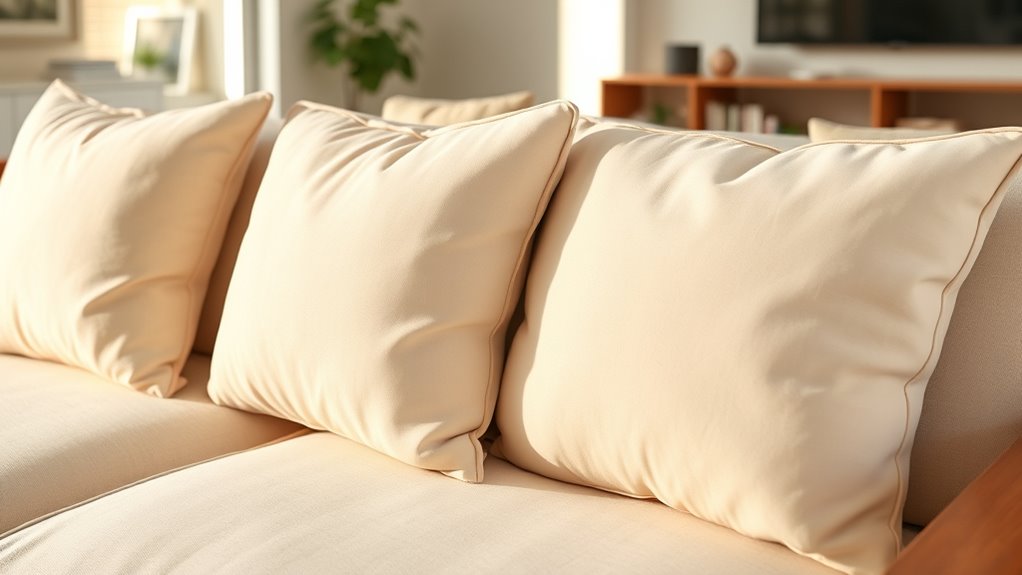
To keep your cushions looking their best, you should regularly fluff them to maintain their shape and support. Using the right cleaning methods helps prevent dirt buildup that can cause sagging over time. Additionally, applying protective covers or treatments can keep your cushions clean and extend their lifespan. Incorporating water-based cleaning techniques can further enhance your cushion maintenance routine.
Regular Fluffing Techniques
Regularly fluffing your couch cushions is essential for maintaining their shape and comfort. This simple habit keeps cushion aesthetics pristine, preventing unsightly sagging. When you fluff your cushions, you help redistribute the filling evenly, adding bounce and resilience. This process also helps preserve fabric color maintenance by reducing the buildup of dirt and oils that can fade your couch’s appearance. To maximize benefits, follow these techniques:
- Flip and rotate cushions weekly to promote even wear.
- Puff and beat cushions to restore their loft and remove dust.
- Use your hands to knead stubborn lumps back into shape.
- Keep cushions dry and avoid excessive sun exposure to protect fabric and color.
- Regularly using performance cookies can help monitor your preferences and improve your overall experience with cushion care tips.
Consistent fluffing keeps your couch looking fresh and inviting—making comfort effortless.
Appropriate Cleaning Methods
Maintaining your couch cushions involves choosing cleaning methods that preserve their fabric and filling. Use gentle cleaning techniques to avoid damaging fabric dyes, which can fade or run if exposed to harsh chemicals or excessive moisture. For spot cleaning, opt for mild detergents and avoid scrubbing vigorously, as this can weaken upholstery adhesives that hold the fabric in place. When deep cleaning, consider using a vacuum with an upholstery attachment to remove dirt without saturating the cushion. Always test cleaning solutions on a hidden area first. Steer clear of bleach or abrasive cleaners, which can harm both fabric dyes and the structural integrity of the filling. Proper cleaning preserves your cushions’ appearance and prevents the materials from breaking down prematurely, helping them stay supportive and comfortable longer. Additionally, regular Kia Tuning modifications can improve the durability and performance of your vehicle, ensuring it remains in top condition for years to come.
Preventative Cushion Protection
Wondering how to keep your couch cushions looking their best over time? Preventative cushion protection is key. Start by choosing the right fabric selection; durable fabrics like microfiber or leather preserve cushion aesthetics longer. Regularly flipping and rotating your cushions prevents uneven wear, ensuring they stay plump and inviting. Use slipcovers or protectors to shield against spills and stains, maintaining fabric integrity. Lastly, keep cushions away from direct sunlight, which can fade colors and weaken fibers. These simple steps help preserve the cushion aesthetics you love and extend the life of your furniture. Incorporating proper maintenance techniques can further enhance cushion longevity. By taking proactive care now, you prevent sagging and maintain a fresh, inviting look for years to come. Your cushions will thank you with lasting comfort and style.
Choosing High-Quality Fillings for Longevity

Choosing high-quality fillings is essential if you want your couch cushions to last longer and stay comfortable. The type of filling directly impacts how well your cushions hold their shape and resist sagging over time. Opt for durable options like high-density foam or down alternatives, which provide better support and bounce back after use. When selecting cushion covers, consider fabric patterns that complement your decor and are sturdy enough to withstand frequent use. A tight weave fabric helps preserve the integrity of the filling, preventing premature wear. Properly chosen fillings and well-made cushion covers work together to maintain your couch’s appearance and comfort, ensuring your cushions stay plump and inviting for years to come. Additionally, choosing trustworthy brands known for quality ingredients and formulations can further enhance the durability of your cushions.
Preventative Measures for Long-Term Cushion Support

To guarantee your couch cushions maintain their support over time, implementing preventative measures is essential. First, regularly rotate and flip cushions to distribute weight evenly, preserving their shape. Second, choose cushions with an aesthetic design that encourages proper sitting posture, reducing strain. Third, select material colors that hide minor stains and wear, keeping your sofa looking fresh longer. Finally, invest in cushions with removable covers, allowing for easy cleaning and maintenance. These steps help prevent sagging, ensuring your sofa stays comfortable and visually appealing. By proactively caring for your cushions, you protect your investment and uphold your home’s aesthetic. Consistent attention to these preventative measures guarantees your couch remains supportive and stylish for years to come.
Frequently Asked Questions
How Can I Identify Early Signs of Cushion Sagging?
To spot early signs of cushion sagging, pay attention to how your cushions look and feel. If they start to flatten or lose their shape, it’s a sign. Check the foam density—lower density foam tends to sag faster. Also, examine the cushion covers; if they become loose or stretched, it indicates the foam underneath may be deteriorating. Addressing these signs early helps keep your cushions comfy and supportive longer.
Are There Specific Cushion Materials That Resist Sagging Better?
Think of your cushions like a castle’s foundation—strong and resilient. You’ll want high foam density materials, which resist sagging better over time. Opt for dense foam cores with a higher ILD rating for durability. Also, choose fabrics with good breathability; they help keep the foam dry and maintain its shape longer. This combination guarantees your cushions stay firm and comfortable, much like a fortress standing strong through the ages.
Can Professional Upholstery Repairs Extend Cushion Lifespan?
Professional upholstery repairs can definitely extend your cushion lifespan. They often include cushion reinforcement, which strengthens the core and helps prevent sagging over time. Additionally, skilled upholstery cleaning removes dirt and debris that can weaken cushions. By combining reinforcement and cleaning, you keep your cushions in better shape longer, so you enjoy a comfortable, supportive couch without frequent replacements. Regular maintenance like this guarantees your cushions stay firm and fresh.
What DIY Methods Effectively Restore Sagging Cushions?
You can effectively restore sagging cushions by replacing or adding foam with higher foam density for better support. Flip and rotate your cushions regularly to distribute wear evenly. Also, consider replacing or tightening cushion covers to improve fit and prevent further sagging. These DIY methods help maintain firmness and extend the life of your cushions, making your sofa look and feel newer without professional repairs.
How Often Should I Replace Couch Cushions for Optimal Support?
Imagine you’re in a time machine, and today’s question is: how often should you replace couch cushions for ideal support? Generally, cushion replacement depends on usage and quality, but you should consider support maintenance every 3-5 years. Regular fluffing, rotating, and adding foam inserts can extend their life. Keep an eye on sagging or uneven support, and replace cushions when necessary to keep your sofa comfortable and supportive.
Conclusion
By following these tips, you’ll keep your cushions firm and inviting for years to come. But remember, even with the best care, some sagging might sneak in over time—unless you take proactive steps today. Imagine sinking into a sofa that feels brand new, every cushion perfectly plump. Stay ahead of the wear and tear, and your couch will remain the cozy centerpiece of your home. The secret to lasting comfort is just a few simple actions away.


